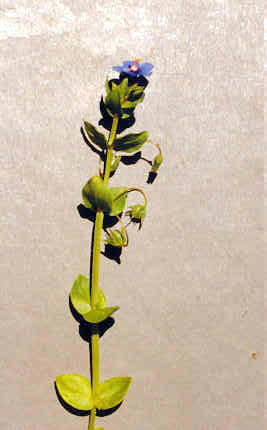
Anagallis arvensis L.
=Anagallis arvensis
var. coerulea (Schreb.) Gren. & Godr.
 |
Anagallis arvensis L.=Anagallis arvensisvar. coerulea (Schreb.) Gren. & Godr.
Primulaceae (Primrose Family)EuropeBlue Pimpernel |
April Photo
Plant Characteristics:
Glabrous diffusely branched annual, the stems 1-2.5 dm. long; lf. blades
ovate to oval, sessile, 0.5-2 cm. long; pedicels slender, 1-3 cm. long; calyx
lobes lanceolate, 3-5 mm. long; corolla rotate, blue, 8-10 mm. across; caps 3-4
mm. long; seed 1 mm. long, triangular, dark, finely pitted.
Habitat:
Common weed at low elevs.; to Atlantic Coast; natur. from Europe.
Mostly March-July.
Name:
Greek, ana, again, and agallein, to delight in , since the
fls. open when the sun strikes them. (Munz,
Flora So. Calif. 715). N.L.,
arvensis, of or belonging to a field.
Latin, caeruleus, dark-blue.
(Jaeger 27,42).
General:
Anagallis arvensis var. arvensis is common in the study area and
is one of the last of the spring plants to dry up.
For a plant that appears to be fragile it is very persistent.
Var. coerulea is rare in the study having been found only in Big
Canyon at a point about half way from the bay to Jamboree Rd. For additional information on Anagallis arvensis see
the data sheet on var. arvensis. (my
comments). About
25 genera and 600 species, widely distributed but most common in the northern
hemisphere. (Munz, Flora So.
Calif. 715). The
1993 Jepson Manual combines var. arvensis and var. coerulea.
Since I have described the separate varieties, I have left the two data
sheets and plant data numbers in the study.
(my comment).
At Bolsa Chica, I have seen a colony of A. Arvensis with white
petals and the same purplish center as flowers with apricot and blue flowers.
This colony was growing next to the common variety with apricot petals.
(my comment)
Text Ref:
Abrams, Vol. III 334; Hickman, Ed. 905; Munz, Flora So. Calif.
716; Roberts 35.
Photo Ref:
April 2 93 # 14A,15A.
Identity: by R. De Ruff, confirmed by John Johnson.
Computer Ref: Plant Data 453.
Have plant specimen.
Last
edit 6/10/03
 |
. April Photo